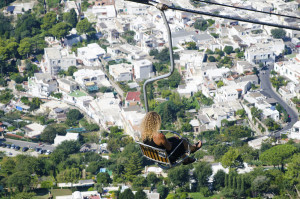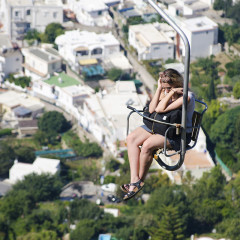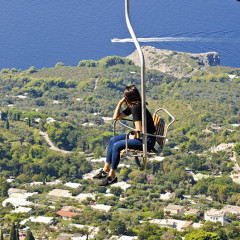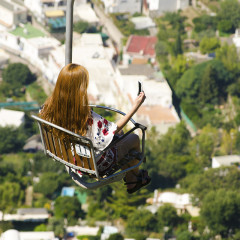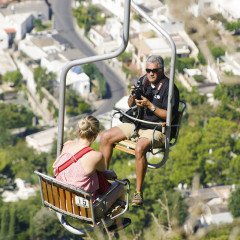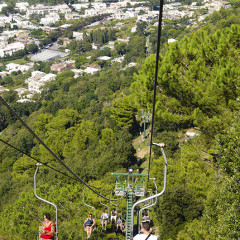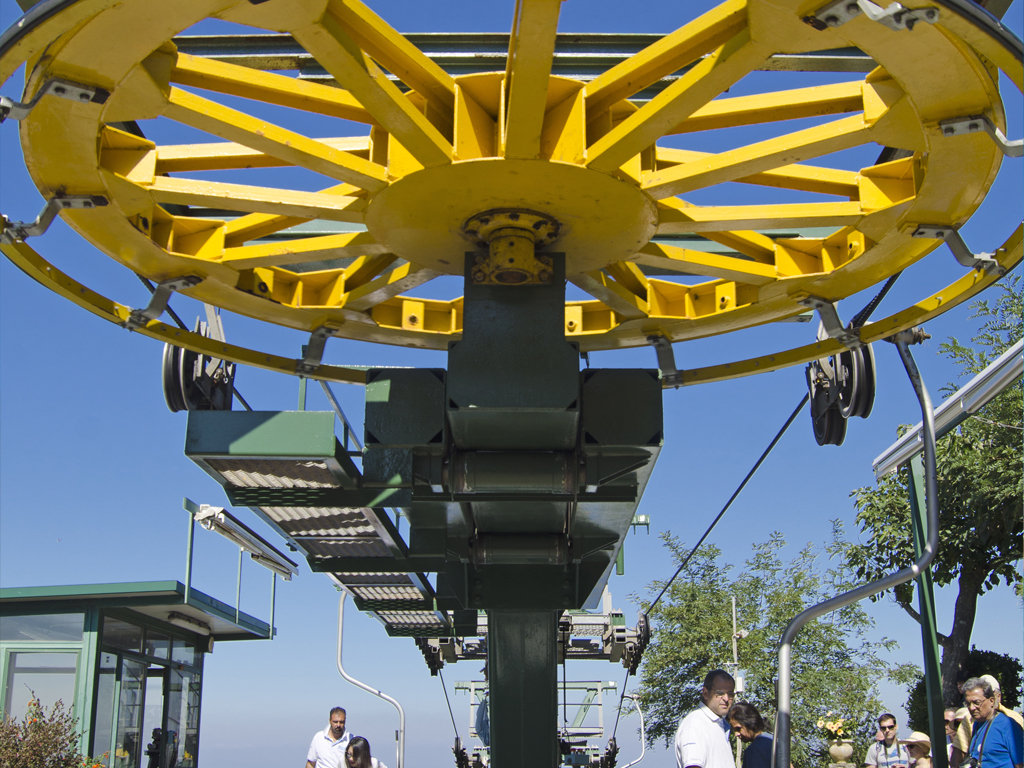
12 minuti sospesi
Con i piedi penzoloni a bordo di uno dei seggiolini che portano sul Monte Solaro. Intorno, lo spettacolo di Capri
testo e foto di Alessandro Scoppa
Anacapri… Anacapri…/ hê criato ’a seggivia/ pe’ fa di’: Oj vita mia!../ vuò gudè?… e viene a ccà! (Anacapri… Anacapri…/ hai creato la seggiovia/ per far dire: Oh vita mia!…/ vuoi godere?… e vieni qui!). Inizia così una vecchia canzone scritta da un anacaprese e dedicata alla seggiovia del comune di sopra. Perché se Capri ha la funicolare, Anacapri ha la seggiovia che da piazza Vittoria sale sulla cima del Monte Solaro, il punto più alto dell’intera isola. 155 seggiolini un po’ rétro, dove si resta seduti sospesi a sei metri dal suolo per i 12 minuti necessari per raggiungere la vetta, non molti, ma che sembrano di più mentre si sfiorano le cime delle vigne e si sorvolano casolari e terrazzamenti. Ecco lì degli ortaggi amorevolmente coltivati lungo le “pezze”, come qui vengono chiamate le terrazze rette da muretti a secco, abbarbicate alle falde del monte; più avanti, tra piante e fiori, appaiono le statue in gesso, i vasi e le fontanelle incrostate di conchiglie che un fantasioso proprietario ha sistemato nel suo giardino. Alla fine, si è a circa seicento metri sul livello del mare, da cui si può godere della vista imparegiabile non solo dell’intera Capri, ma anche delle altre isole del golfo, del Vesuvio, della Penisola sorrentina e, nelle giornate particolarmente terse, perfino delle coste del Cilento.
Proprio perché innamorati di questo panorama, oltre che l’uno dell’altra, l’ingegnere Francesco Uliscia e la moglie Emily Incarnati, che a Capri c’erano venuti in luna di miele e sul Solaro si erano inerpicati a piedi, decisero di condividere con tutti quello 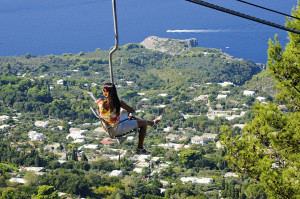 scenario meraviglioso e le emozioni che suscitava. Nacque così, negli anni Cinquanta, la seggiovia. L’opera, che richiese un ingente sforzo economico, progettuale e non ultimo fisico, essendo enormi le difficoltà di lavorare sullo scosceso fianco della montagna, segnerà la spinta definitiva allo sviluppo turistico di Anacapri. Certo, per chi soffre di vertigini non è esattamente l’esperienza giusta, soprattutto in discesa, quando i cavi d’acciaio ai quali si reggono i seggiolini, sono tutti proiettati verso il fondovalle creando un’illusione da montagne russe. Ma venire ad Anacapri e non salire sulla seggiovia è un affronto alla bellezza.
scenario meraviglioso e le emozioni che suscitava. Nacque così, negli anni Cinquanta, la seggiovia. L’opera, che richiese un ingente sforzo economico, progettuale e non ultimo fisico, essendo enormi le difficoltà di lavorare sullo scosceso fianco della montagna, segnerà la spinta definitiva allo sviluppo turistico di Anacapri. Certo, per chi soffre di vertigini non è esattamente l’esperienza giusta, soprattutto in discesa, quando i cavi d’acciaio ai quali si reggono i seggiolini, sono tutti proiettati verso il fondovalle creando un’illusione da montagne russe. Ma venire ad Anacapri e non salire sulla seggiovia è un affronto alla bellezza.
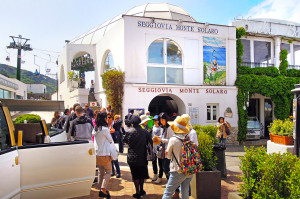 Una volta, quando si oltrepassavano i piloni, il passaggio dei sostegni delle sedie sulle ruote che facevano scorrere il cavo era accompagnato dal caratteristico sobbalzare e da quel “ta-ta-ta-ta-tac” che scandiva il percorso; oggi, dopo l’ultimo rinnovamento della struttura, la salita si svolge fluida e nell’assoluto silenzio, rotto solo dai suoni della natura o dalle voci di chi si chiama e scherza da una sedia all’altra. Sulla cima, il giardino panoramico ospita anche un bar con sedie a sdraio, La Canzone del Cielo (quale altro nome gli si sarebbe potuto dare?) e perfino una piscina, scavata utilizzando la dinamite; le esplosioni venivano mascherate dai fuochi d’artificio che l’ingegnere Uliscia vi faceva coincidere per non turbare la serenità dell’isola. Ma attenzione, la piscina è vuota: troppo difficoltoso far arrivare fin lassù l’acqua dal mare!
Una volta, quando si oltrepassavano i piloni, il passaggio dei sostegni delle sedie sulle ruote che facevano scorrere il cavo era accompagnato dal caratteristico sobbalzare e da quel “ta-ta-ta-ta-tac” che scandiva il percorso; oggi, dopo l’ultimo rinnovamento della struttura, la salita si svolge fluida e nell’assoluto silenzio, rotto solo dai suoni della natura o dalle voci di chi si chiama e scherza da una sedia all’altra. Sulla cima, il giardino panoramico ospita anche un bar con sedie a sdraio, La Canzone del Cielo (quale altro nome gli si sarebbe potuto dare?) e perfino una piscina, scavata utilizzando la dinamite; le esplosioni venivano mascherate dai fuochi d’artificio che l’ingegnere Uliscia vi faceva coincidere per non turbare la serenità dell’isola. Ma attenzione, la piscina è vuota: troppo difficoltoso far arrivare fin lassù l’acqua dal mare!
Dal Monte Solaro non si dovrebbe rinunciare a percorrere il sentiero che porta nella non lontana valletta di Cetrella con il Museo della Civiltà Contadina, allestito nella casa che fu dello scrittore Compton Mackenzie, e il quattrocentesco eremo di Santa Maria. Questo è custodito dal 1971 dai fratelli Carmine e Ottavio Russo, che ne conservano gelosamente le chiavi ed è grazie a loro se, da maggio a settembre, un paio di volte a settimana si può visitare questo angolo di pace dove non è escluso che venga offerto un fragrante caffè nella suggestiva cucina dell’eremo.
Da Cetrella è poi possibile scendere in paese a piedi, passando al di sotto della seggiovia che continua a salire su, in cima a quest’isola dove anche i mezzi di trasporto diventano attrazioni.
12 minutes suspended in air
With feet dangling, on the chairlift that goes up to Monte Solaro. All around, the panorama of Capri
text and photos by Alessandro Scoppa
Anacapri… Anacapri…/ hê criato ’a seggivia/ pe’ fa di’: Oj vita mia!…/ vuò gudè?… e viene a ccà! (Anacapri… Anacapri…/ you’ve created the chairlift/ to make us say: Oh darling!…/ do you want to have fun?… well come here!) That’s the beginning to an old song by an Anacapri writer dedicated to the Anacapri chairlift. Because while Capri has its funicular railway, Anacapri has a chairlift that goes up from Piazza Vittoria to the summit of Monte Solaro, the highest point on the whole island. 155 somewhat retro cable chairs, where you sit six metres above ground for 12 minutes before reaching the top; it’s not very long, but it seems longer as you skim the tops of vineyards and fly over cottages and terraced fields. Down below are vegetables lovingly cultivated along the “pieces”, as they call the terraced fields supported by dry stone walls that cling to the slopes of the mountain; further on, among the plants and flowers are plaster statues, vases, and the fountains encrusted with sea shells that an imaginative house owner has arranged around his garden. Finally you’re at the top, six hundred metres above sea level, from where you can enjoy incomparable views not only of the whole of Capri, but also of the other islands in the gulf, and of Mount Vesuvius, the Sorrento Peninsula, and, on particularly clear days, as far as the Cilentan coast. Engineer Francesco Uliscia and his wife, Emily Incarnati, fell in love not only with each other but with this panorama when they came to Capri on their honeymoon and climbed Solaro on foot, and they decided to share the wonderful spectacle and the emotions it aroused with everyone else. And that’s how the chairlift came about in the 1950s. The work required a tremendous commitment financially, in planning terms and not least in sheer physical effort, given the huge difficulties entailed in working on the rocky flanks of the mountain, but it gave the definitive push to the development of tourism in Anacapri. Of course, for anyone who suffers from vertigo it’s not the best experience, especially going down, when the steel cables that hold the chairs are all inclined downwards towards the bottom of the valley, creating the illusion of a roller coaster. But to come to Anacapri and not go for a ride in the chairlift is an affront to the beauty of the place. In the past, when you passed the pylons and the chair supports ran over the wheels that allow the cable to pass through, it would be accompanied by a typical jolting and “ta-ta-ta-ta-tac” that marked the route; nowadays, following the latest renovation of the structure, the ascent flows smoothly and in absolute silence, broken only by the sounds of nature or the voices of people as they jokingly call each other from one chair to another. At the summit, the panoramic garden also houses a bar with deck chairs: La Canzone del Cielo (The Song of Heaven – what other name could you give the place?) and even a pool, excavated with dynamite; the explosions were masked by fireworks that the engineer Uliscia had let off at the same time so as not to disturb the calm of the island. Be warned though, the pool is empty: it proved too difficult to bring sea water all the way up there! From Monte Solaro don’t miss the opportunity to take a walk along the path that leads to the valley of Cetrella, not too far away, where you’ll find the Museum of the Peasant-farmer Civilization (Museo della Civiltà Contadina) in the house that belonged to writer Compton Mackenzie, as well as the 15th century hermitage of Santa Maria. Since 1971, the hermitage has been looked after by the brothers Carmine and Ottavio Russo, who are jealous guardians of the keys, and it’s thanks to them that from May to September you can visit this peaceful corner a couple of times a week, where you might even be offered a delicious-smelling coffee in the beautiful kitchen of the hermitage. From Cetrella you can also walk down to the town, passing below the chairlift that continues its ascent to the summit of this island, where even the means of transport are a tourist attraction.
Lo chiamavano Acchiappanuvole
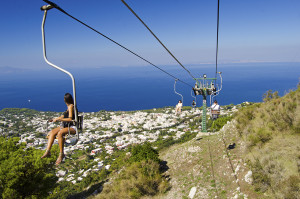 Al mattino, l’aria calda e umida che sale dal mare incontra la roccia più fredda, e condensa in una cortina di nubi che avvolge la sommità dell’isola, che per questo è anche detta Acchiappanuvole. Ma il vero nome della cima più alta di Capri è Monte Solaro: i suoi 589 metri sul livello del mare sono i primi a ricevere la luce del mattino, tingendo di rosa e arancio la ripida parete calcarea. Il Monte Solaro si staglia quasi in verticale dal centro dell’isola, e la divide nei due comuni di Capri, in basso, e Anacapri, adagiata più in alto sulla vallata che dalla cima scende fino al mare nella zona del Faro e dei Fortini.
La seggiovia porta proprio sulla cima, con il suo panorama mozzafiato. Ma attenzione, la vista non è tutto: da qui sono possibili molteplici escursioni: le più semplici verso Cetrella o la Crocetta, dove svetta la Croce in ferro battuto che domina Anacapri, o quelle appena più impegnative verso le antenne di Monte Cappello e il Monte Barbarossa, con il castello omonimo. I più esperti possono cimentarsi con gli scoscesi sentieri del Passetiello e dell’Anginola, che scendono fino a Capri, o con quello meno conosciuto di Monte Cocucchio che sale dal Belvedere della Migliera, a strapiombo sul mare.
Oltre 900 le specie vegetali presenti e una ricca fauna composta per lo più da uccelli migratori, nonché da una famigliola di capre selvatiche, “adottate” dagli anziani Carolina e Gennaro: la loro è l’ultima casa sul monte; al di là, solo la natura incontaminata che fa del Solaro uno dei pochi luoghi dell’isola dove anche in alta stagione regnano incontrastati pace e silenzio. | They called it Cloud-catcher. In the morning, the warm, humid air that rises from the sea meets the colder rock and condenses into a curtain of clouds veiling the summit of the island: hence the name Cloud-catcher. But the real name of the highest peak on Capri is Monte Solaro: at 589 metres above sea level, it is the first place to catch the morning light as it tinges its steep limestone wall with pink and orange. Monte Solaro arises almost vertically in the centre of the island, dividing the two towns, Capri below, and Anacapri nestled higher up the valley that descends from the peak down to the sea, in the area of the Lighthouse and the Fortini (forts).
The chairlift goes right up to the summit, with its breathtaking panorama. But the view is not all it has to offer: there are also lots of possible excursions from here. Among the simplest are those to Cetrella or the Crocetta, the site of the wrought iron cross that dominates Anacapri, or the slightly more strenuous walk to the TV antennas on Monte Cappello and to Monte Barbarossa, with its eponymous castle. The most experienced hikers can test themselves on the steep paths of the Passetiello and Anginola, that descend right down to Capri, or on the less well-known path of Monte Cocucchio that climbs up from the Belvedere della Migliera, on a precipitous cliff high above the sea.
There are over 900 species of plant and a rich fauna consisting mainly of migratory birds, as well as a family of wild goats, “adopted” by an elderly couple, Carolina and Gennaro, who live in the last house on the mountain; above them there is only unspoilt nature, making Monte Solaro one of the few places on the island where peace and silence reign undisturbed even in peak tourist season.
Al mattino, l’aria calda e umida che sale dal mare incontra la roccia più fredda, e condensa in una cortina di nubi che avvolge la sommità dell’isola, che per questo è anche detta Acchiappanuvole. Ma il vero nome della cima più alta di Capri è Monte Solaro: i suoi 589 metri sul livello del mare sono i primi a ricevere la luce del mattino, tingendo di rosa e arancio la ripida parete calcarea. Il Monte Solaro si staglia quasi in verticale dal centro dell’isola, e la divide nei due comuni di Capri, in basso, e Anacapri, adagiata più in alto sulla vallata che dalla cima scende fino al mare nella zona del Faro e dei Fortini.
La seggiovia porta proprio sulla cima, con il suo panorama mozzafiato. Ma attenzione, la vista non è tutto: da qui sono possibili molteplici escursioni: le più semplici verso Cetrella o la Crocetta, dove svetta la Croce in ferro battuto che domina Anacapri, o quelle appena più impegnative verso le antenne di Monte Cappello e il Monte Barbarossa, con il castello omonimo. I più esperti possono cimentarsi con gli scoscesi sentieri del Passetiello e dell’Anginola, che scendono fino a Capri, o con quello meno conosciuto di Monte Cocucchio che sale dal Belvedere della Migliera, a strapiombo sul mare.
Oltre 900 le specie vegetali presenti e una ricca fauna composta per lo più da uccelli migratori, nonché da una famigliola di capre selvatiche, “adottate” dagli anziani Carolina e Gennaro: la loro è l’ultima casa sul monte; al di là, solo la natura incontaminata che fa del Solaro uno dei pochi luoghi dell’isola dove anche in alta stagione regnano incontrastati pace e silenzio. | They called it Cloud-catcher. In the morning, the warm, humid air that rises from the sea meets the colder rock and condenses into a curtain of clouds veiling the summit of the island: hence the name Cloud-catcher. But the real name of the highest peak on Capri is Monte Solaro: at 589 metres above sea level, it is the first place to catch the morning light as it tinges its steep limestone wall with pink and orange. Monte Solaro arises almost vertically in the centre of the island, dividing the two towns, Capri below, and Anacapri nestled higher up the valley that descends from the peak down to the sea, in the area of the Lighthouse and the Fortini (forts).
The chairlift goes right up to the summit, with its breathtaking panorama. But the view is not all it has to offer: there are also lots of possible excursions from here. Among the simplest are those to Cetrella or the Crocetta, the site of the wrought iron cross that dominates Anacapri, or the slightly more strenuous walk to the TV antennas on Monte Cappello and to Monte Barbarossa, with its eponymous castle. The most experienced hikers can test themselves on the steep paths of the Passetiello and Anginola, that descend right down to Capri, or on the less well-known path of Monte Cocucchio that climbs up from the Belvedere della Migliera, on a precipitous cliff high above the sea.
There are over 900 species of plant and a rich fauna consisting mainly of migratory birds, as well as a family of wild goats, “adopted” by an elderly couple, Carolina and Gennaro, who live in the last house on the mountain; above them there is only unspoilt nature, making Monte Solaro one of the few places on the island where peace and silence reign undisturbed even in peak tourist season.
A casa di Mackenzie
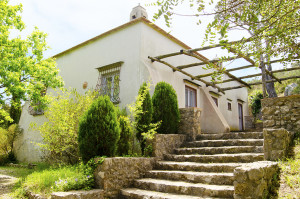 Immaginate una delle vertiginose scogliere isolane trasformate in un variopinto giardino a terrazze digradanti fino al mare. Questa era l’utopia dello scrittore scozzese Compton Mackenzie, che nel 1918 acquistò una casetta sul sentiero di Cetrella, insieme al retrostante burrone di Cala Ventroso. Una frana lo convinse dell’impossibilità del suo progetto. Ma anche senza giardino sospeso, in quella sorta di cottage in stile caprese Mackenzie organizzava allegri festini finché, lasciata Capri, fu acquistata da Edwin Cerio e poi, di fatto, abbandonata. Nel 1995 gli Amici di Cetrella hanno restaurato la casa, rifatto il pergolato di ingresso, ripulito il giardino. Oggi, grazie all’attività dei volontari e alle donazioni degli isolani che hanno portato lassù gli oggetti che una volta erano d’uso quotidiano, Casa Mackenzie di Anacapri è il Museo della Civiltà Contadina, custode di un pezzo della memoria storica isolana. | At the house of Mackenzie. Imagine one of the sheer cliffs of Capri turned into a gaily-coloured garden with terraces sloping down to the sea. This was the dream of Scottish writer Compton Mackenzie, who bought a cottage on the path to Cetrella in 1918, together with the Cala Ventroso gully behind it. A landslide convinced him of the impossibility of his project. But even though it was without a hanging garden, Mackenzie organized fun-filled parties in his Capri-style cottage until, after he left Capri, it was bought by Edwin Cerio and then, to all intents and purposes, abandoned. In 1995, the Friends of Cetrella restored the house, renovated the entrance pergola and tidied up the garden. Today, thanks to the work of volunteers and donations by the islanders, who brought objects that had once been part of everyday life up to the house, Casa Mackenzie in Anacapri is the Museum of the Peasant-Farmer Civilization, custodian of a piece of the island’s history.
Immaginate una delle vertiginose scogliere isolane trasformate in un variopinto giardino a terrazze digradanti fino al mare. Questa era l’utopia dello scrittore scozzese Compton Mackenzie, che nel 1918 acquistò una casetta sul sentiero di Cetrella, insieme al retrostante burrone di Cala Ventroso. Una frana lo convinse dell’impossibilità del suo progetto. Ma anche senza giardino sospeso, in quella sorta di cottage in stile caprese Mackenzie organizzava allegri festini finché, lasciata Capri, fu acquistata da Edwin Cerio e poi, di fatto, abbandonata. Nel 1995 gli Amici di Cetrella hanno restaurato la casa, rifatto il pergolato di ingresso, ripulito il giardino. Oggi, grazie all’attività dei volontari e alle donazioni degli isolani che hanno portato lassù gli oggetti che una volta erano d’uso quotidiano, Casa Mackenzie di Anacapri è il Museo della Civiltà Contadina, custode di un pezzo della memoria storica isolana. | At the house of Mackenzie. Imagine one of the sheer cliffs of Capri turned into a gaily-coloured garden with terraces sloping down to the sea. This was the dream of Scottish writer Compton Mackenzie, who bought a cottage on the path to Cetrella in 1918, together with the Cala Ventroso gully behind it. A landslide convinced him of the impossibility of his project. But even though it was without a hanging garden, Mackenzie organized fun-filled parties in his Capri-style cottage until, after he left Capri, it was bought by Edwin Cerio and then, to all intents and purposes, abandoned. In 1995, the Friends of Cetrella restored the house, renovated the entrance pergola and tidied up the garden. Today, thanks to the work of volunteers and donations by the islanders, who brought objects that had once been part of everyday life up to the house, Casa Mackenzie in Anacapri is the Museum of the Peasant-Farmer Civilization, custodian of a piece of the island’s history.
L’eremo incantato
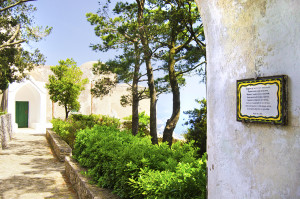 Proprio al termine dell’erto sentiero del Passetiello sorge l’eremo di Santa Maria a Cetrella. Sospeso tra cielo e mare, in una posizione da far invidia alle più lussuose ville capresi, la chiesetta coperta da due rustiche volte a crociera e l’annesso piccolo convento furono eretti tra il XIV e il XV secolo e alla fine del 1800 ospitavano ancora l’ultimo monaco eremita. Le finestre dell’antica cucina incorniciano i Faraglioni, mentre dalla terrazza ombreggiata da un pergolato a pali di castagno Capri e il Golfo di Napoli sembrano a portata di mano. In passato alla Madonnina che vi si venera erano devoti soprattutto i marinai, che qui si sentivano più vicini al cielo pregando prima di imbarcarsi per la pesca al corallo. Oggi, l’eremo è la meta finale della Via Crucis della Settimana Santa, che sale dal centro di Anacapri lungo l’antico sentiero contrassegnato dalle stazioni in bronzo fuse nella roccia.
Proprio al termine dell’erto sentiero del Passetiello sorge l’eremo di Santa Maria a Cetrella. Sospeso tra cielo e mare, in una posizione da far invidia alle più lussuose ville capresi, la chiesetta coperta da due rustiche volte a crociera e l’annesso piccolo convento furono eretti tra il XIV e il XV secolo e alla fine del 1800 ospitavano ancora l’ultimo monaco eremita. Le finestre dell’antica cucina incorniciano i Faraglioni, mentre dalla terrazza ombreggiata da un pergolato a pali di castagno Capri e il Golfo di Napoli sembrano a portata di mano. In passato alla Madonnina che vi si venera erano devoti soprattutto i marinai, che qui si sentivano più vicini al cielo pregando prima di imbarcarsi per la pesca al corallo. Oggi, l’eremo è la meta finale della Via Crucis della Settimana Santa, che sale dal centro di Anacapri lungo l’antico sentiero contrassegnato dalle stazioni in bronzo fuse nella roccia.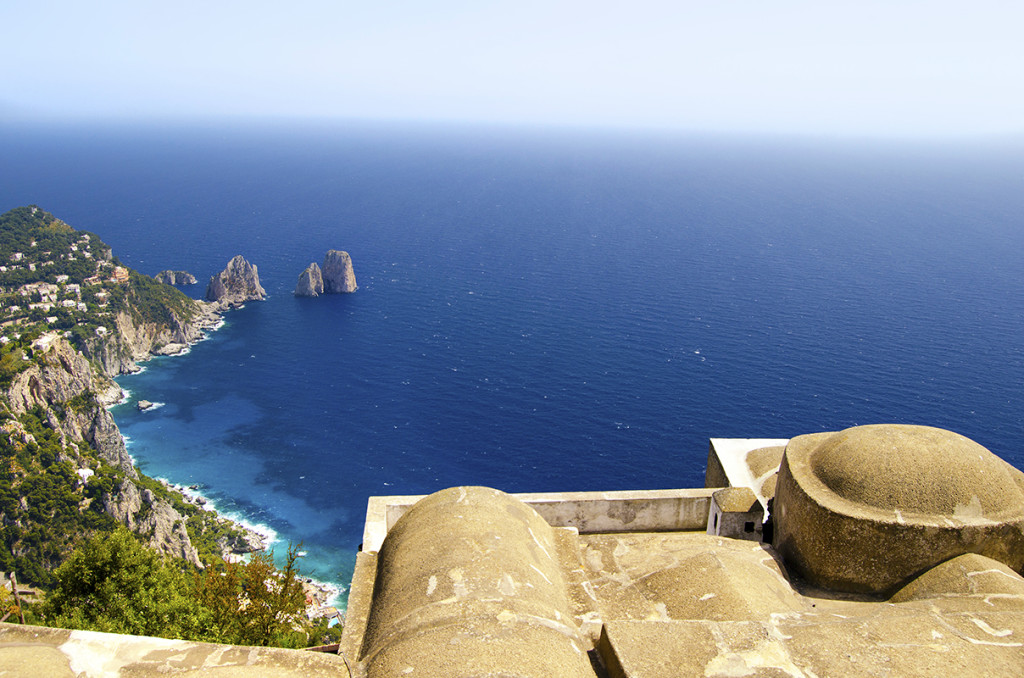
Alcuni ritengono che il nome della valle derivi da Venere Citerea; lasciandosi rapire dalla luce e dal panorama di lassù, non sorprende che Cetrella potrebbe essere proprio il Cetrella dove gli antichi avrebbero innalzato un tempio alla dea della bellezza e dell’amore.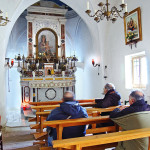
The enchanted hermitage
Right at the end of the precipitous Passetiello path stands the hermitage of Santa Maria a Cetrella. Suspended between sky and sea, in a position that must strike envy in even the most luxurious Capri villas, the little church, with its two aisles roofed with rustic cross-vaulting, and the small monastic annex were built between the 14th and 15th centuries and until the end of the 19th century were still home to the last of the hermit monks. The Faraglioni are framed in the windows of the old kitchen, while from the terrace, shaded by a pergola of chestnut wood poles, Capri and the Gulf of Naples seem just a short distance away. In the past, the devotees of the Madonna who is venerated there were mainly sailors, who felt closer to heaven as they prayed up there before setting off in their boats to fish for coral. Today, the hermitage is the final destination of the Via Crucis in Holy Week, on the route that climbs up from the centre of Anacapri along the old path, marked by the bronze stations of the cross fused into the rock.
Some believe that the name of the valley derives from the Cytherean Venus and, if you allow yourself to be entranced by the light and the panorama from up there, you won’t find it surprising that Cetrella could be the very place where the ancients built a temple to the goddess of beauty and love.


